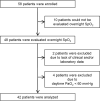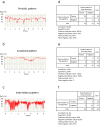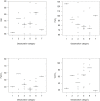Prospective Study of Nocturnal Desaturation in Patients Receiving Home Oxygen Therapy
- PMID: 34602521
- PMCID: PMC8545634
- DOI: 10.2169/internalmedicine.6329-20
Prospective Study of Nocturnal Desaturation in Patients Receiving Home Oxygen Therapy
Abstract
Objective Nocturnal desaturation is common in patients with chronic respiratory disease and often worsens the prognosis. Therefore, it should be diagnosed accurately and appropriately treated. The aim of this study was to clarify the diversity of nocturnal desaturation. Methods We prospectively enrolled 58 outpatients diagnosed with chronic respiratory disease receiving home oxygen therapy and measured nocturnal SpO2 using a portable oximeter. We classified nocturnal desaturation (3% decrease in SpO2 from baseline) into three patterns: periodic pattern (desaturation duration of <655 seconds), sustained pattern (desaturation duration of ≥655 seconds), and intermittent pattern (desaturation and recovery of SpO2 repeated with a cycle of several minutes). Results Nocturnal hypoxemia (SpO2≤88% for more than 5 minutes) was found in 23.8% of patients. The percentage of patients with chronic obstructive pulmonary disease (COPD) was significantly higher in the nocturnal hypoxemia group than in the non-hypoxemia group (80% vs. 40.6%, p=0.03). Desaturation with a periodic pattern was found in 81% of patients, desaturation with a sustained pattern was found in 40.5% of patients, and desaturation with an intermittent pattern was found in 59.5% of patients. In patients with COPD, desaturation with a periodic pattern was found in 85.7%, desaturation with a sustained pattern was found in 47.6%, and desaturation with an intermittent pattern was found in 57.1%. Conclusion The SpO2 waveform of nocturnal hypoxemia was able to be classified into three patterns. Suitable treatment for each pattern might improve the prognosis of these patients.
Keywords: COPD; nocturnal desaturation; obstructive sleep apnoea; rapid eye movement.
Conflict of interest statement
Yoshihiro Nishimura: Research funding, Teijin Pharma.
Figures




Similar articles
-
Characteristics of the nocturnal desaturation waveform pattern of SpO2 in COPD patients: an observational study.Respir Res. 2021 Oct 26;22(1):276. doi: 10.1186/s12931-021-01868-9. Respir Res. 2021. PMID: 34702275 Free PMC article.
-
Analysis of nocturnal desaturation waveforms using algorithms in patients with idiopathic pulmonary fibrosis.Sleep Breath. 2022 Sep;26(3):1079-1086. doi: 10.1007/s11325-021-02456-3. Epub 2021 Aug 21. Sleep Breath. 2022. PMID: 34420134 Free PMC article.
-
Evaluating nocturnal oxygen desaturation in COPD--revised.Respir Med. 2011 Sep;105(9):1331-7. doi: 10.1016/j.rmed.2011.04.003. Epub 2011 May 10. Respir Med. 2011. PMID: 21561753
-
[Nocturnal desaturation in chronic obstructive pulmonary disease].Recenti Prog Med. 2002 Dec;93(12):686-94. Recenti Prog Med. 2002. PMID: 12557800 Review. Italian.
-
Exertional desaturation in patients with chronic obstructive pulmonary disease.COPD. 2009 Dec;6(6):478-87. doi: 10.3109/15412550903341497. COPD. 2009. PMID: 19938972 Review.
Cited by
-
Characteristics of the nocturnal desaturation waveform pattern of SpO2 in COPD patients: an observational study.Respir Res. 2021 Oct 26;22(1):276. doi: 10.1186/s12931-021-01868-9. Respir Res. 2021. PMID: 34702275 Free PMC article.
-
Randomized crossover trial of a demand oxygen delivery system in nocturnal hypoxemia.Sci Rep. 2024 Sep 3;14(1):20505. doi: 10.1038/s41598-024-71320-7. Sci Rep. 2024. PMID: 39227657 Free PMC article. Clinical Trial.
-
Evaluation of obstructive sleep apnea syndrome in sarcoidosis patients: a clinical and polysomnographic analysis.Sleep Breath. 2025 Jul 23;29(4):251. doi: 10.1007/s11325-025-03375-3. Sleep Breath. 2025. PMID: 40699258
References
-
- Fletcher EC, Miller J, Divine GW, Fletcher JG, Miller T. Nocturnal oxyhemoglobin desaturation in COPD patients with arterial oxygen tensions above 60 mm Hg. Chest 92: 604-608, 1987. - PubMed
-
- Carroll N, Walshaw MJ, Evans CC, Hind CR. Nocturnal oxygen desaturation in patients using long-term oxygen therapy for chronic airflow limitation. Respir Med 84: 199-201, 1990. - PubMed

